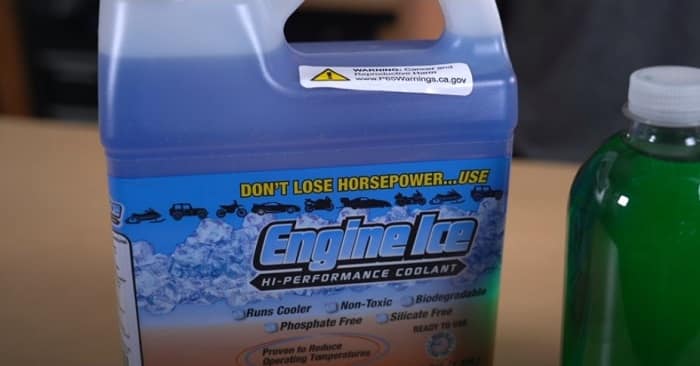Deprecated: mb_convert_encoding(): Handling HTML entities via mbstring is deprecated; use htmlspecialchars, htmlentities, or mb_encode_numericentity/mb_decode_numericentity instead in /home/u598013642/domains/motorcyclegear101.com/public_html/wp-content/themes/acabado/functions.php on line 2160
Deprecated: mb_convert_encoding(): Handling HTML entities via mbstring is deprecated; use htmlspecialchars, htmlentities, or mb_encode_numericentity/mb_decode_numericentity instead in /home/u598013642/domains/motorcyclegear101.com/public_html/wp-content/themes/acabado/functions.php on line 2160
Did you know that your motorcycle’s engine is only about 30 efficient? that means 70 of the gasoline it burns is wasted as heat.
How Often Should You Change Your Motorcycle Coolant?
To manage the heat, most modern motorcycles rely on liquid cooling, and guess what? Just like your engine oil and your brake fluid, engine coolant needs to be replaced at regular intervals, usually every 24 months or 24 000 miles.
What Does Motorcycle Coolant Do?
The fluid in your engine’s coolant is mostly just water, mixing in additives help protect the system from freezing, help raise the boiling point and, most importantly, fight corrosion.
Just like the additives that are in your engine oil, that stuff gets used up or worn out over time, which is why it’s really important to service your cooling system every other year.
To tackle the job, you will need to start your motorcycle and bring it up to room temperature, tools to remove the coolant drain bolt and bodywork, a drain pan, a sealable container for disposal, fresh coolant, a funnel, and a new sealing washer for the drain bolt.

Rags are always nice to have any time you’re working on your motorcycle, and you might also want to pick up some distilled water and white vinegar to flush your cooling system, but we’ll get to that a little later.
Before you get started, make sure your engine is cool to the touch. A hot engine will not only have scalding coolant, but it will also be pressurized, so it’s going to come flying out in a hurry.
Most OE coolants are ethylene glycol, which is poisonous, so you don’t want to put it down the drain or leave it sitting around in the drain pan.
Supposedly it’s kind of sweet, and pets like to drink it, and if they do, there’s a quick countdown to kidney failure. So if you have pets or want to be safe, you can always use a propylene glycol coolant, non-toxic.
As a heads up, this is usually a quick and easy job on a naked bike or any machine where the radiator cap, reservoir tank, and drain bolt are out in the open.
Unfortunately, many modern full-fared bikes hide that stuff behind panels that are a total pain to remove.
So rather than tackling your coolant system service as a standalone task, you might want to combine it with other stuff that also requires the bodywork to be removed, like changing your air filter or your spark plugs.
How To Drail The Coolant
There’s going to be a drain bolt for the cooling system, typically at the bottom of the water pump cover, but it might be at some other low point in the plumbing. You will be able to identify it by the copper sealing washer under the bolt head.
The coolant always squirts out of the engine faster than I expect, so what I do is I leave the radiator cap closed, and I hold the pan up to the drain. Then I’ll crack the radiator cap just a little bit to help speed up the flow and lower the pan down to the ground.
If you do happen to spill any coolant, it’s not a big deal. Just make sure you wipe it up with a rag and plenty of water.
Since the objective is to get rid of all the old coolant, we also need to drain the overflow tank, and this acts as a reservoir to ensure that the cooling system stays full.
If there’s excess heat or pressure, the radiator cap will release fluid into the reservoir tank, and then as the engine cools, it will draw fluid back into the radiator via a vacuum.
To drain the tank, you might need to remove it, and if it looks dirty, go ahead and rinse it out or even scrub it with a bottle brush.
Now that the system is fully drained take a look at the radiator hoses to check for cracks and chafing and squeeze them to make sure they’re still pliable since they can become brittle with age.
It’s also a good idea to wiggle the hose clamps to make sure they are tight and intact, and also take a look at the radiator to check for mangled cooling fins, which you can straighten with a screwdriver.
Some manuals suggest flushing the cooling system or even adding a descaling agent as part of the service. Honestly, though, I don’t bother unless it’s a used bike, and I suspect that it hasn’t been properly maintained.
But if your manual calls for it or wants to do an extra thorough job, you can concoct a mixture of 50 water and 50 vinegar and run it in the system until the cooling fan kicks on.
This mildly acidic solution will help scrub any scale or rust that has accumulated. Just make sure you let the bite cool completely before draining it, and then flush the system with pure distilled water before proceeding with the refill.
The old coolant has been drained, perhaps you have even flushed the plumbing, and It is nearly time to add fresh coolant. But first, slap a new sealing washer on the drain bolt. Just be gentle, it’s a little guy, and you don’t want to strip it.
What Is The Best Motorcycle Coolant?
Just like with engine oils and chain lube, people can get wound up over what to use. There are lots of options for cooling out there, some with wild claims in addition to their wild colors, but please do not get distracted, do not overthink it.

Just reference your owner’s manual and know that any benefits from fancy coolants are likely to be negligible or just non-existent. as mentioned earlier, though, a propylene-based coolant is a good alternative, cooling efficiency. Aside it is non-toxic and biodegradable, which I, for one, find very appealing.
is a good alternative, cooling efficiency. Aside it is non-toxic and biodegradable, which I, for one, find very appealing.
Whatever coolant you choose, it will likely come pre-diluted and ready to use, but if it is a concentrate, you need to mix it with distilled water at the proper ratio, usually 50/50.
It’s important to use distilled water and not tap water, which might contain minerals, and cause scale in your cooling system, which will deplete the additives in the coolant.
It doesn’t matter how good you think your aim is; a funnel is the only way to go when adding coolant to your radiator. Pause every so often to let air escape the pipes, and rock the bike back and forth to help coax air out of the system.
Some motorcycles have a bleed bolt in the cooling system, and you crack it to release trapped air, then close it once coolant starts dribbling out. Not all bikes have them, which is why referencing the shop manual for your particular model is important.
Where do I put coolant in my motorcycle?
Once the system is filled up to the bottom of the radiator neck, leave the cap off, start the bike and let it run for a minute or two, blipping the throttle to help move any remaining air out of the system.
If needed, top the radiator and move on to the reservoir tank, which you should fill to the upper line.
With that, your cooling system is tuned up; all that’s left to do is dispose of the old coolant, which you can usually do via your city or town’s recycling program.
Don’t forget to mark the date and the mileage in your workshop manual so you can stay on top of your maintenance.
This service is easy to ignore since there’s no window into your radiator to show you how gross your coolant has gotten, but if you want your engine to stay healthy, you got to stay on top of this.

